BMW MOTORRAD K 1200 S 2004 Rider's Manual (in English)
Manufacturer: BMW MOTORRAD, Model Year: 2004, Model line: K 1200 S, Model: BMW MOTORRAD K 1200 S 2004Pages: 162, PDF Size: 2.99 MB
Page 71 of 162
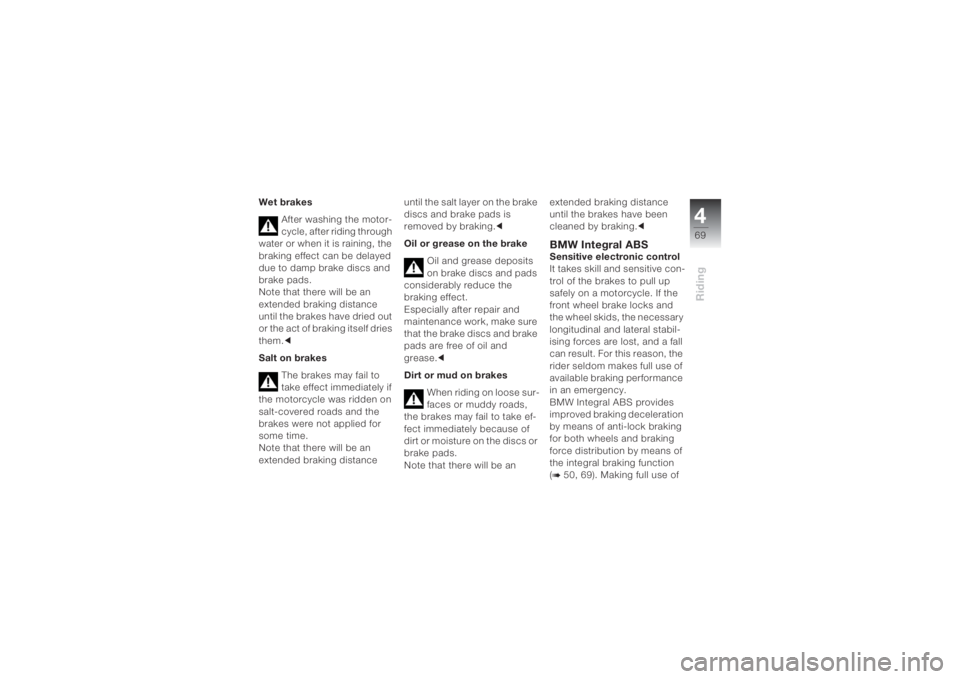
469Riding
Wet brakes
After washing the motor-
cycle, after riding through
water or when it is raining, the
braking effect can be delayed
due to damp brake discs and
brake pads.
Note that there will be an
extended braking distance
until the brakes have dried out
or the act of braking itself dries
them.c
Salt on brakes
The brakes may fail to
take effect immediately if
the motorcycle was ridden on
salt-covered roads and the
brakes were not applied for
some time.
Note that there will be an
extended braking distance until the salt layer on the brake
discs and brake pads is
removed by braking.c
Oil or grease on the brake
Oil and grease deposits
on brake discs and pads
considerably reduce the
braking effect.
Especially after repair and
maintenance work, make sure
that the brake discs and brake
pads are free of oil and
grease.c
Dirt or mud on brakes
When riding on loose sur-
faces or muddy roads,
the brakes may fail to take ef-
fect immediately because of
dirt or moisture on the discs or
brake pads.
Note that there will be an extended braking distance
until the brakes have been
cleaned by braking.c
BMW Integral ABSSensitive electronic control
It takes skill and sensitive con-
trol of the brakes to pull up
safely on a motorcycle. If the
front wheel brake locks and
the wheel skids, the necessary
longitudinal and lateral stabil-
ising forces are lost, and a fall
can result. For this reason, the
rider seldom makes full use of
available braking performance
in an emergency.
BMW Integral ABS provides
improved braking deceleration
by means of anti-lock braking
for both wheels and braking
force distribution by means of
the integral braking function
(b 50, 69). Making full use of
Page 72 of 162
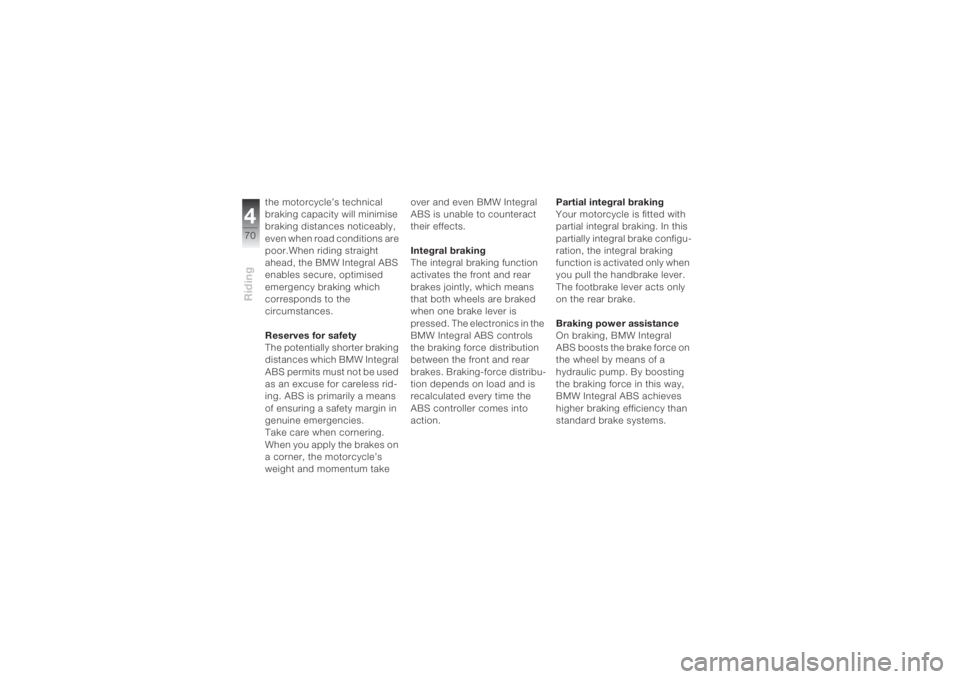
Riding470
the motorcycle’s technical
braking capacity will minimise
braking distances noticeably,
even when road conditions are
poor.When riding straight
ahead, the BMW Integral ABS
enables secure, optimised
emergency braking which
corresponds to the
circumstances.
Reserves for safety
The potentially shorter braking
distances which BMW Integral
ABS permits must not be used
as an excuse for careless rid-
ing. ABS is primarily a means
of ensuring a safety margin in
genuine emergencies.
Take care when cornering.
When you apply the brakes on
a corner, the motorcycle’s
weight and momentum take over and even BMW Integral
ABS is unable to counteract
their effects.
Integral braking
The integral braking function
activates the front and rear
brakes jointly, which means
that both wheels are braked
when one brake lever is
pressed. The electronics in the
BMW Integral ABS controls
the braking force distribution
between the front and rear
brakes. Braking-force distribu-
tion depends on load and is
recalculated every time the
ABS controller comes into
action. Partial integral braking
Your motorcycle is fitted with
partial integral braking. In this
partially integral brake configu-
ration, the integral braking
function is activated only when
you pull the handbrake lever.
The footbrake lever acts only
on the rear brake.
Braking power assistance
On braking, BMW Integral
ABS boosts the brake force on
the wheel by means of a
hydraulic pump. By boosting
the braking force in this way,
BMW Integral ABS achieves
higher braking efficiency than
standard brake systems.
Page 73 of 162
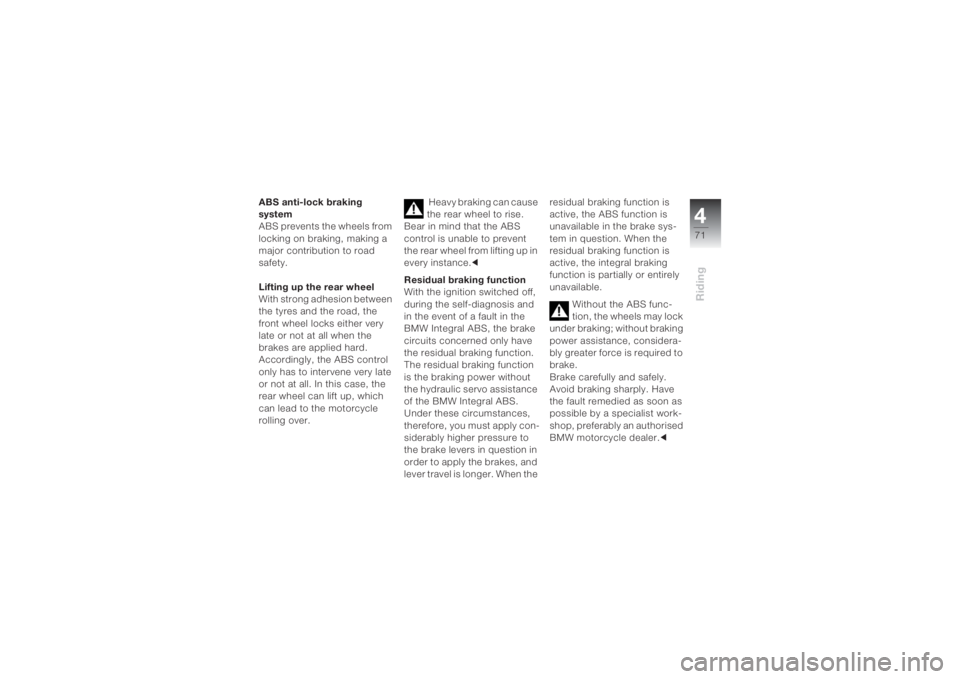
471Riding
ABS anti-lock braking
system
ABS prevents the wheels from
locking on braking, making a
major contribution to road
safety.
Lifting up the rear wheel
With strong adhesion between
the tyres and the road, the
front wheel locks either very
late or not at all when the
brakes are applied hard.
Accordingly, the ABS control
only has to intervene very late
or not at all. In this case, the
rear wheel can lift up, which
can lead to the motorcycle
rolling over. Heavy braking can cause
the rear wheel to rise.
Bear in mind that the ABS
control is unable to prevent
the rear wheel from lifting up in
every instance.c
Residual braking function
With the ignition switched off,
during the self-diagnosis and
in the event of a fault in the
BMW Integral ABS, the brake
circuits concerned only have
the residual braking function.
The residual braking function
is the braking power without
the hydraulic servo assistance
of the BMW Integral ABS.
Under these circumstances,
therefore, you must apply con-
siderably higher pressure to
the brake levers in question in
order to apply the brakes, and
lever travel is longer. When the residual braking function is
active, the ABS function is
unavailable in the brake sys-
tem in question. When the
residual braking function is
active, the integral braking
function is partially or entirely
unavailable.
Without the ABS func-
tion, the wheels may lock
under braking; without braking
power assistance, considera-
bly greater force is required to
brake.
Brake carefully and safely.
Avoid braking sharply. Have
the fault remedied as soon as
possible by a specialist work-
shop, preferably an authorised
BMW motorcycle dealer.c
Page 74 of 162
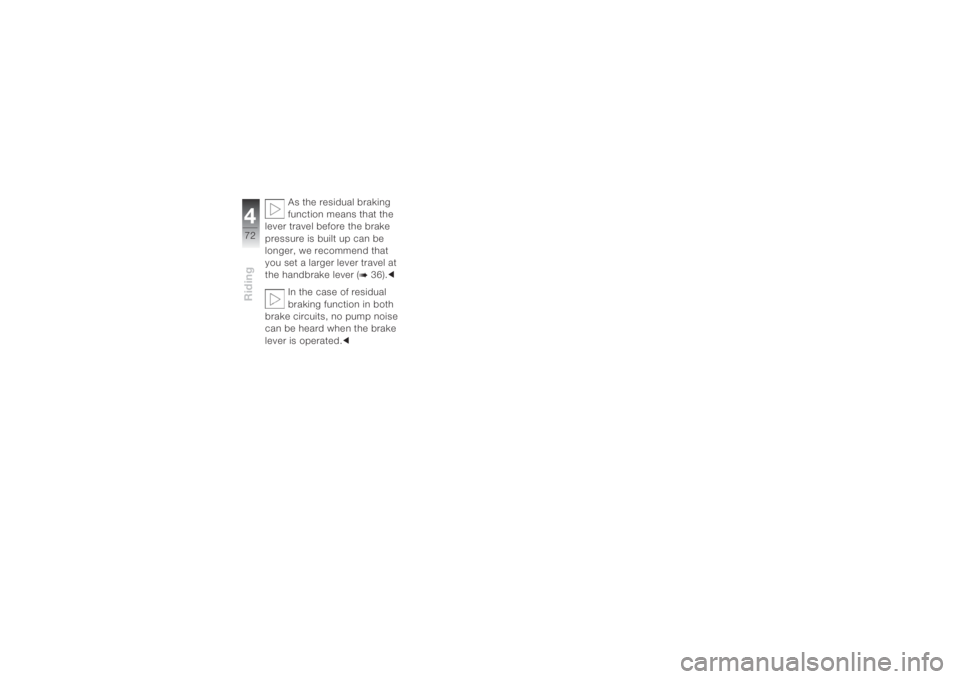
Riding472
As the residual braking
function means that the
lever travel before the brake
pressure is built up can be
longer, we recommend that
you set a larger lever travel at
the handbrake lever (
b 36).c
In the case of residual
braking function in both
brake circuits, no pump noise
can be heard when the brake
lever is operated.c
Page 75 of 162
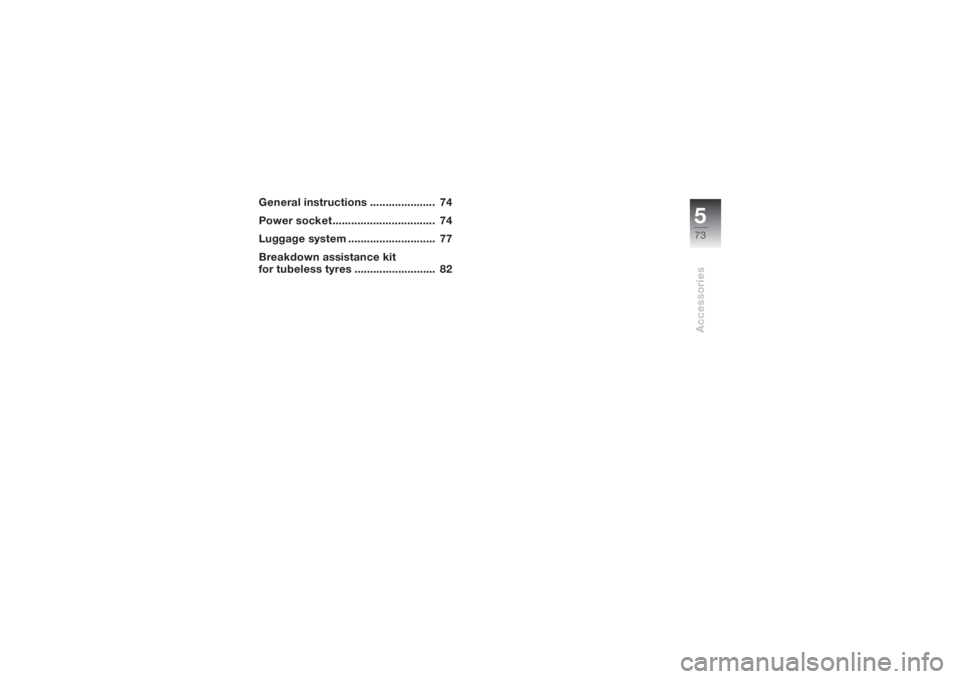
573Accessories
General instructions ..................... 74
Power socket................................. 74
Luggage system ............................ 77
Breakdown assistance kit
for tubeless tyres .......................... 82
Page 76 of 162
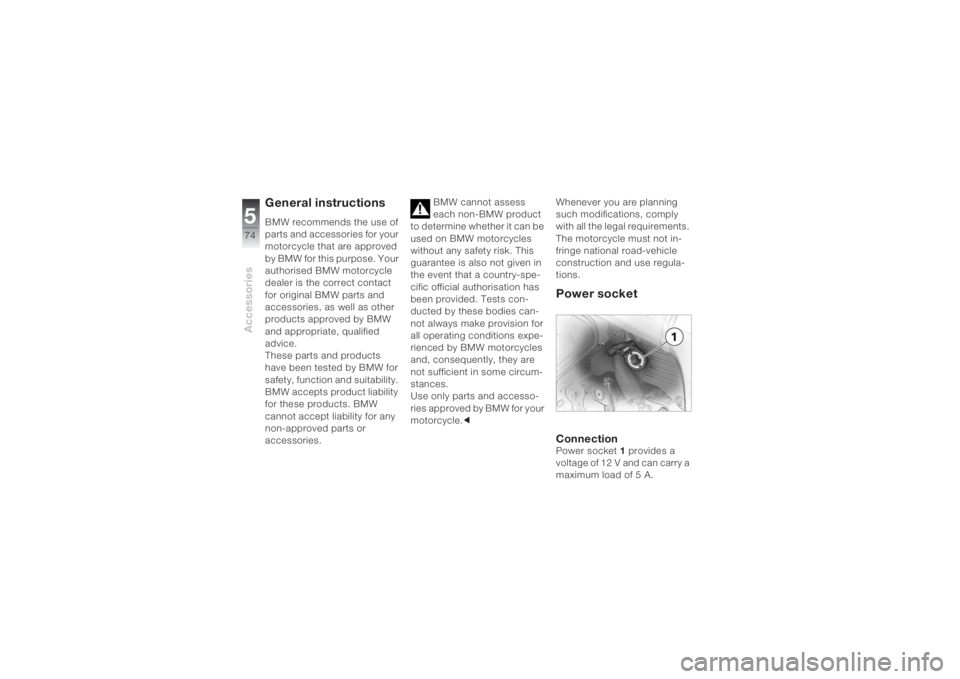
Accessories574
General instructionsBMW recommends the use of
parts and accessories for your
motorcycle that are approved
by BMW for this purpose. Your
authorised BMW motorcycle
dealer is the correct contact
for original BMW parts and
accessories, as well as other
products approved by BMW
and appropriate, qualified
advice.
These parts and products
have been tested by BMW for
safety, function and suitability.
BMW accepts product liability
for these products. BMW
cannot accept liability for any
non-approved parts or
accessories. BMW cannot assess
each non-BMW product
to determine whether it can be
used on BMW motorcycles
without any safety risk. This
guarantee is also not given in
the event that a country-spe-
cific official authorisation has
been provided. Tests con-
ducted by these bodies can-
not always make provision for
all operating conditions expe-
rienced by BMW motorcycles
and, consequently, they are
not sufficient in some circum-
stances.
Use only parts and accesso-
ries approved by BMW for your
motorcycle.cWhenever you are planning
such modifications, comply
with all the legal requirements.
The motorcycle must not in-
fringe national road-vehicle
construction and use regula-
tions.
Power socketConnectionPower socket1 provides a
voltage of 12 V and can carry a
maximum load of 5 A.
Page 77 of 162
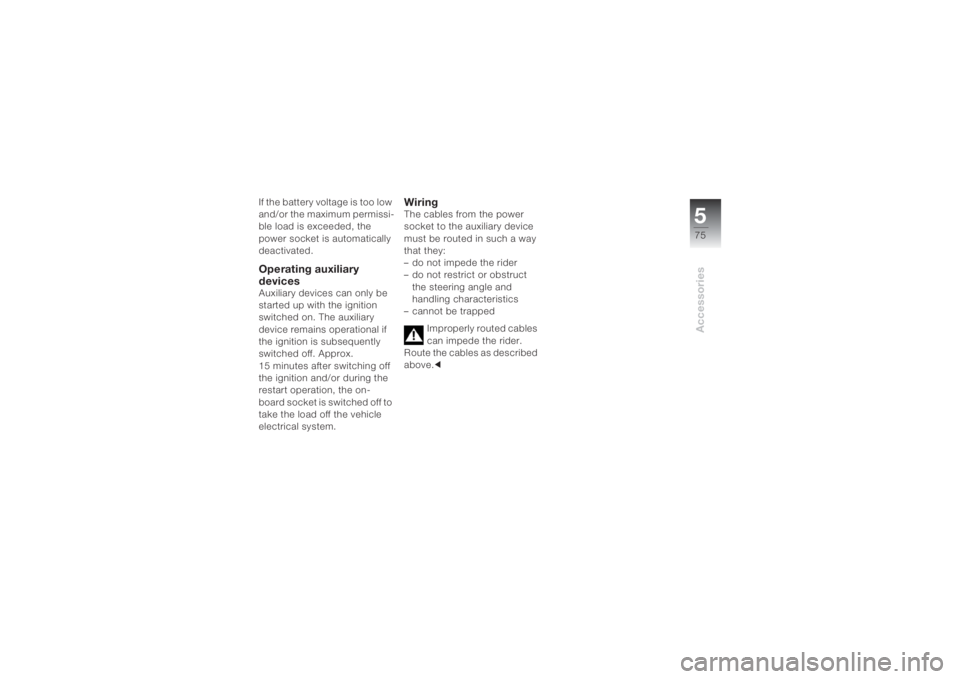
575Accessories
If the battery voltage is too low
and/or the maximum permissi-
ble load is exceeded, the
power socket is automatically
deactivated.Operating auxiliary
devicesAuxiliary devices can only be
started up with the ignition
switched on. The auxiliary
device remains operational if
the ignition is subsequently
switched off. Approx.
15 minutes after switching off
the ignition and/or during the
restart operation, the on-
board socket is switched off to
take the load off the vehicle
electrical system.
WiringThe cables from the power
socket to the auxiliary device
must be routed in such a way
that they:
– do not impede the rider
– do not restrict or obstruct
the steering angle and
handling characteristics
– cannot be trapped
Improperly routed cables
can impede the rider.
Route the cables as described
above.c
Page 78 of 162
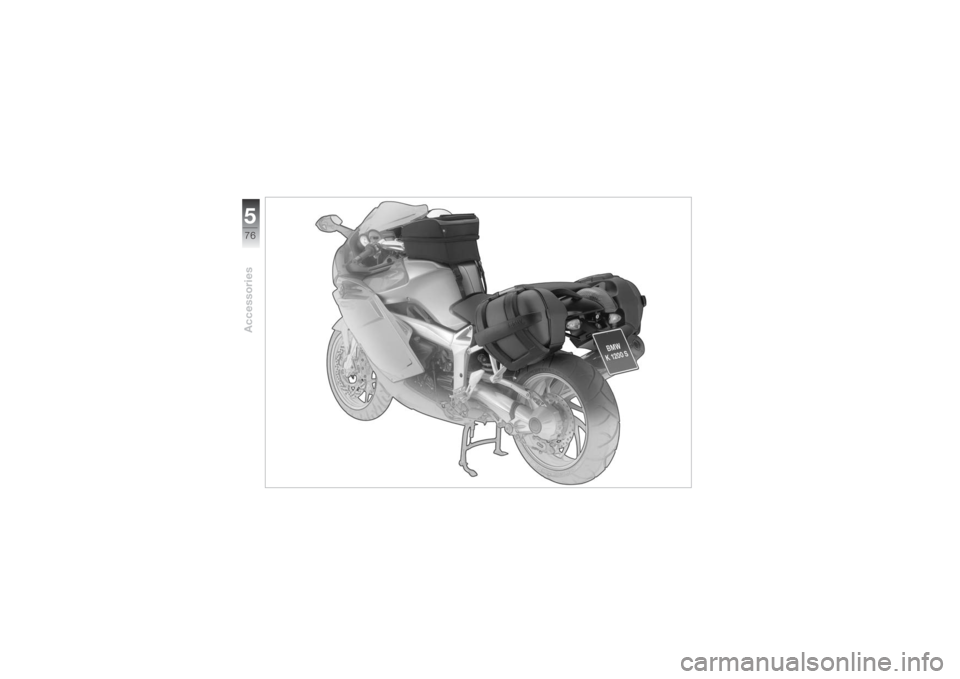
Accessories576
Page 79 of 162
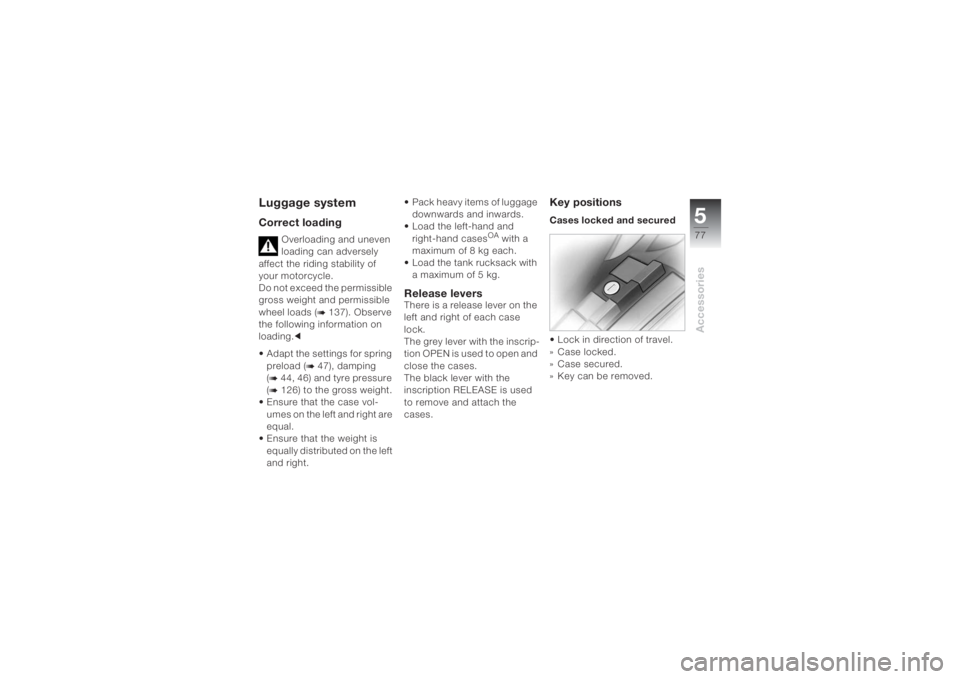
577Accessories
Luggage systemCorrect loading
Overloading and uneven
loading can adversely
affect the riding stability of
your motorcycle.
Do not exceed the permissible
gross weight and permissible
wheel loads (
b 137). Observe
the following information on
loading.c
• Adapt the settings for spring
preload (
b 47), damping
(
b 44, 46) and tyre pressure
(b 126) to the gross weight.
• Ensure that the case vol-
umes on the left and right are
equal.
• Ensure that the weight is
equally distributed on the left
and right.• Pack heavy items of luggage
downwards and inwards.
• Load the left-hand and
right-hand cases
OA with a
maximum of 8 kg each.
• Load the tank rucksack with
a maximum of 5 kg.
Release leversThere is a release lever on the
left and right of each case
lock.
The grey lever with the inscrip-
tion OPEN is used to open and
close the cases.
The black lever with the
inscription RELEASE is used
to remove and attach the
cases.
Key positionsCases locked and secured • Lock in direction of travel.
» Case locked.
»Case secured.
» Key can be removed.
Page 80 of 162
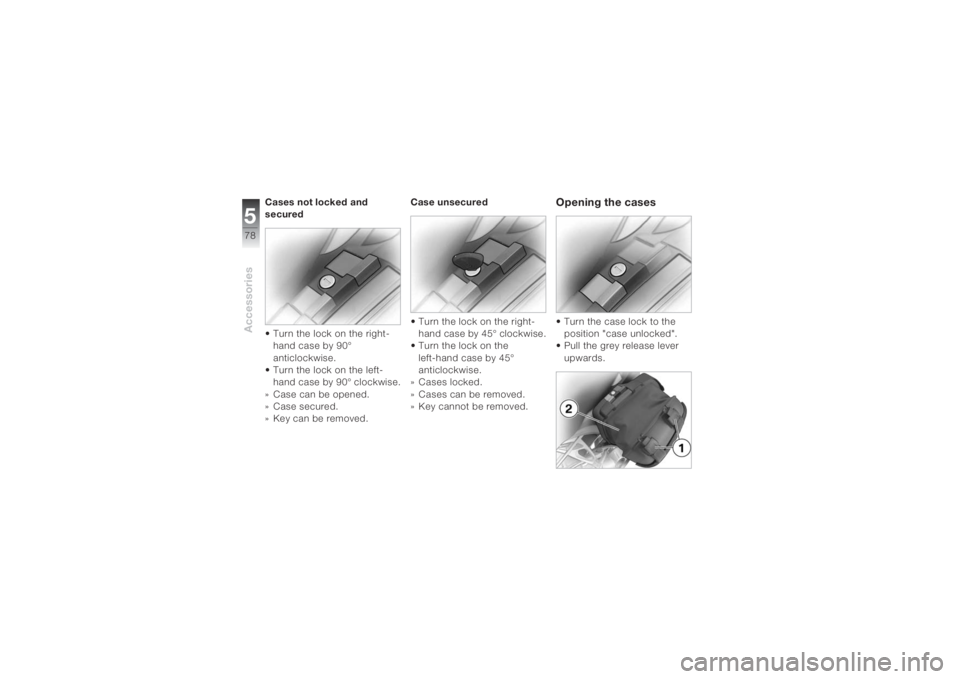
Accessories578
Cases not locked and
secured • Turn the lock on the right-
hand case by 90°
anticlockwise.
• Turn the lock on the left-
hand case by 90° clockwise.
» Case can be opened.
»Case secured.
»Key can be removed.Case unsecured
• Turn the lock on the right-
hand case by 45° clockwise.
• Turn the lock on the
left-hand case by 45°
anticlockwise.
» Cases locked.
» Cases can be removed.
» Key cannot be removed.
Opening the cases • Turn the case lock to the
position "case unlocked".
• Pull the grey release lever
upwards.